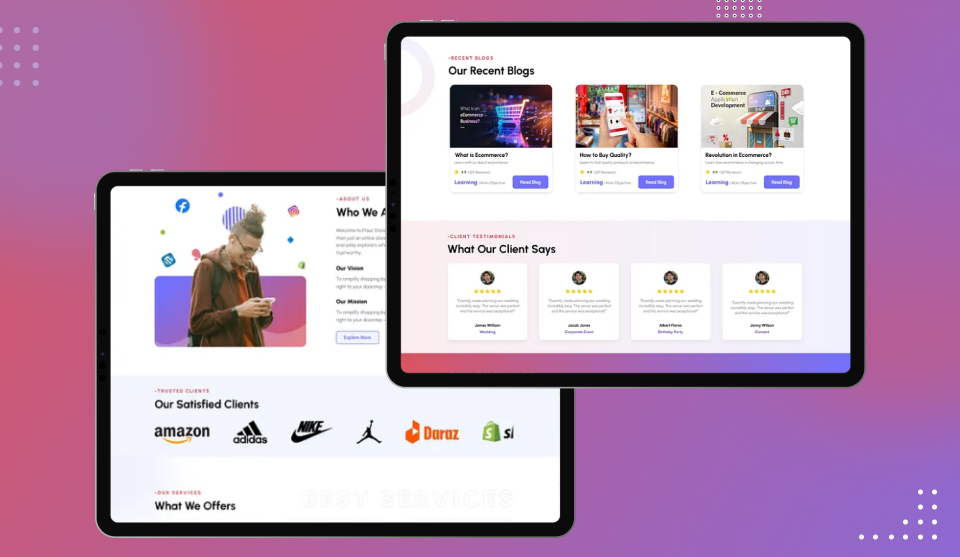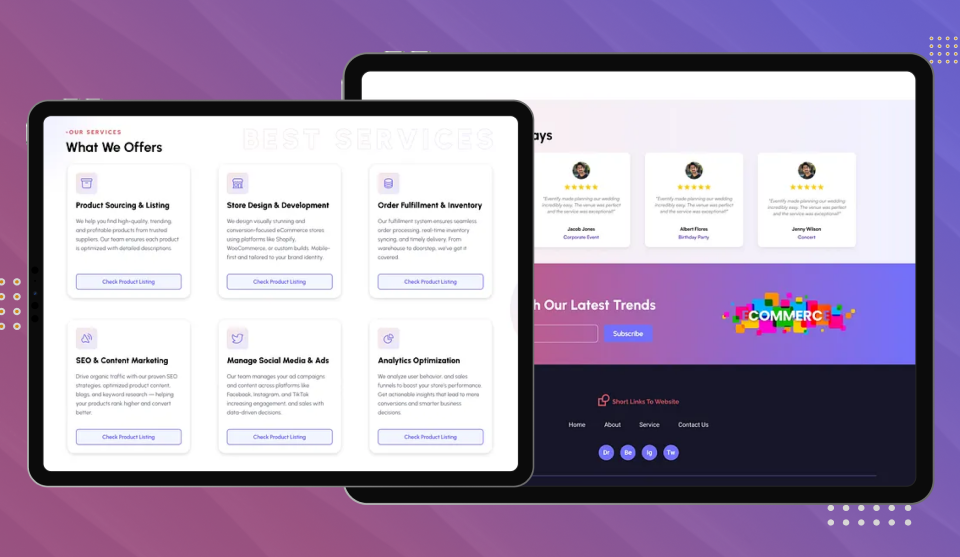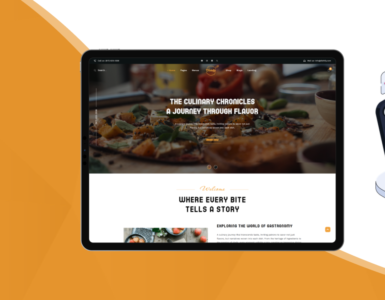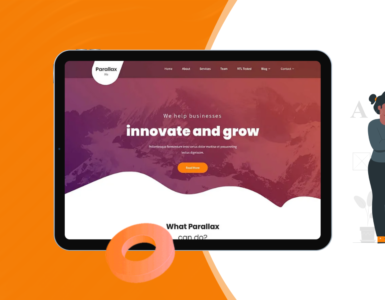Introduction
As the digital realm continues to expand, success hinges on developing web applications that are not only powerful but also secure and built to scale effortlessly. For businesses aiming to lead in the online world, choosing the right framework can significantly impact both development time and long-term success. Laravel, a PHP-based web application framework, stands out as one of the most powerful tools for developers and businesses alike.
From startups to large enterprises, many are turning to Laravel web development for its elegant syntax, powerful tools, and ability to streamline complex processes. In this blog, we will explore the best practices that can help you master Laravel and build modern web applications that are secure, maintainable, and future-ready.
Why Choose Laravel for Web Development?
Before diving into best practices, it’s essential to understand why Laravel has become a top choice among developers and businesses:
- Clean and elegant syntax
- Laravel uses the MVC pattern, which simply means your code stays neat, organized, and easier to work with as your project grows.
- Follows the MVC architecture, making your code cleaner and easier to manage.
- Comes with built-in features like routing, session handling, user authentication, and caching—so you don’t have to start from scratch.
- Uses the Blade templating engine, which simplifies UI development and keeps your frontend code organized.
- Eloquent ORM for effortless database management
- Extensive documentation and vibrant community
By partnering with a Laravel development company like Siddhi Infosoft, businesses can leverage these benefits to build powerful applications with reduced development cycles and costs.
Best Practices for Mastering Laravel
1. Follow PSR Standards and MVC Architecture
Laravel follows PSR (PHP Standard Recommendations), which helps ensure consistency and maintainability. Embrace these standards throughout your application. The MVC (Model-View-Controller) architecture helps you keep your code clean, structured, and easy to manage:
Models handle data and business logic.
- Views manage the frontend/UI.
- Controllers act as the link between the Model and the View, handling user input and updating both as needed.
This structure allows better collaboration, testing, and code reusability.
2. Utilize Laravel’s Artisan Console
Artisan, Laravel’s command-line interface, can automate repetitive tasks and improve productivity. You can use Artisan to:
- Generate models, controllers, and migrations
- Clear caches and routes
- Schedule tasks
- Run unit tests
Example:
bash
php artisan make:controller ProductController
Mastering Artisan helps developers save time and maintain consistency across large applications.

3. Leverage Eloquent ORM Effectively
Laravel’s Eloquent ORM simplifies database interactions. It allows developers to work with databases using Active Record implementation instead of writing complex SQL queries.
Best Practices:
- Use relationships (hasOne, hasMany, belongsTo) wisely.
- Avoid N+1 queries by eager loading (with()).
- Create scopes for common queries to keep models clean.
php
CopyEdit
public function scopeActive($query)
{
return $query->where('status', 'active');
}
A reliable Laravel web development company will always ensure optimal use of Eloquent to reduce database load and improve performance.
Read More: https://www.siddhiinfosoft.com/blog/5g-mobile-apps-social-impact/
4. Secure Your Application
Security plays a vital role in today’s web applications, protecting data and ensuring safe user interactions. Laravel provides built-in security features, but developers must implement them correctly.
Best Practices:
- Use Laravel’s built-in authentication and authorization.
- Sanitize user input using Request validation.
- Protect against CSRF attacks with @csrf in forms.
- Always hash passwords for security—Laravel uses Bcrypt by default to ensure encrypted storage.
- Set proper database and file permissions.
5. Use Laravel Mix for Asset Management
Laravel Mix simplifies compiling and minifying CSS, JavaScript, and other frontend assets. With just a few lines of code, you can integrate modern tools like Webpack.
Advantages:
- Faster frontend performance
- Easier versioning and cache busting
- Support for SASS/LESS and Vue/React
Example:
js
mix.js('resources/js/app.js', 'public/js')
.sass('resources/sass/app.scss', 'public/css');
6. Implement Testing and Test-Driven Development
Testing ensures your application behaves as expected. Laravel comes with built-in PHPUnit integration and provides convenient helper methods to support different types of testing, from unit to feature tests:
- Unit Testing: Test individual components.
- Feature Testing: Test HTTP requests and application logic.
Example:
php
public function testUserCanLogin()
{
$response = $this->post('/login', [
'email' => 'test@example.com',
'password' => 'password123'
]);
$response->assertRedirect('/dashboard');
}
A Laravel development company that values quality will always prioritize automated testing in the development pipeline.
7. Use Queues for Time-Consuming Tasks
Queues allow you to delay time-consuming tasks such as sending emails or processing uploads. Laravel supports various queue drivers such as Redis, Beanstalkd, and Amazon SQS, allowing efficient background job processing.
Example Tasks for Queues:
- Sending notifications
- Generating reports
- Running batch jobs
Implementing queues improves response times and user experience.
8. Utilize Events and Listeners
Events help decouple your application logic. For example, when a user registers, you may want to send a welcome email, log the activity, and update analytics—using events simplifies this process.
php
CopyEdit
Event::listen(
UserRegistered::class,
[SendWelcomeEmail::class, 'handle']
);
This modular approach leads to cleaner code and better scalability.
9. Environment Configuration
Avoid hardcoding credentials or environment-specific settings. Use Laravel’s .env file to manage configuration settings for environment-specific values like database credentials, API keys, mail services, and app debugging modes.
- Database credentials
- Mail settings
- API keys
- Debug modes
Tip: Never commit .env to your repository.
10. Keep Laravel and Dependencies Updated
Laravel releases regular updates, including new features, performance enhancements, and security patches. Keeping your application and its packages up to date is critical for stability and security.
Use:
bash
composer update
A reliable Laravel web development services provider like Siddhi Infosoft ensures regular maintenance and version upgrades.
Read More: https://www.siddhiinfosoft.com/blog/food-app-development-usa/
Laravel in Real-World Applications
Laravel is powering everything from small business websites to enterprise-level applications. Whether it’s an e-commerce platform, CRM system, or SaaS product, Laravel’s flexibility and scalability make it a perfect fit.
Some well-known use cases:
- Content Management Systems
- APIs and Backend Systems
- Booking Platforms
- Marketplace Portals
- Educational Platforms
If you’re a business looking to create a feature-rich web application, partnering with a Laravel development company like Siddhi Infosoft can bring your vision to life efficiently.
Why Choose Siddhi Infosoft for Laravel Web Development?
Siddhi Infosoft is a trusted name in the field of Laravel web development services. With years of experience, our expert team delivers scalable, secure, and innovative solutions tailored to meet your business goals.
What Sets Us Apart:
- Experienced Laravel Developers
- Custom Application Development
- Agile Methodology
- API Development & Integration
- Maintenance & Support
- Transparent Pricing and Timelines
Whether you’re a startup or an established business, we align our Laravel expertise with your growth trajectory.
Conclusion
Mastering Laravel goes beyond just learning syntax—it involves following best practices, writing clean and secure code, and leveraging the full potential of the framework. As Laravel continues to evolve, staying updated and adopting modern development practices becomes even more crucial.
By following these best practices and partnering with a seasoned Laravel development company like Siddhi Infosoft, you can build modern web applications that are secure, scalable, and high-performing.
Ready to build your next Laravel project?
Let Siddhi Infosoft be your technology partner and transform your ideas into reality with our top-notch Laravel web development services.
Frequently Asked Questions (FAQs)
1. What is Laravel and why is it popular for web development?
Laravel is a modern PHP framework known for its clean syntax, robust features, and developer-friendly tools. It follows the MVC (Model-View-Controller) pattern and includes built-in support for routing, authentication, session handling, caching, and more—making web application development faster and more maintainable.
2. What are the key benefits of using Laravel over other PHP frameworks?
Laravel offers:
- Clean MVC architecture
- Blade templating engine
- Eloquent ORM for database operations
- Built-in security features
- Artisan CLI for automation
- Laravel Mix for asset management
These tools streamline development, improve performance, and reduce long-term maintenance costs.
3. How does Laravel ensure security in web applications?
Laravel includes built-in security mechanisms like:
- CSRF protection
- Password hashing with Bcrypt
- Input validation
- Route protection through authentication and authorization middleware
Following Laravel’s best practices ensures that your application is secure against common web vulnerabilities.

4. Is Laravel suitable for enterprise-level applications?
Absolutely. Laravel scales well and supports features like caching, queue management, event broadcasting, and API development, which are essential for large, enterprise-grade applications. It also integrates smoothly with cloud platforms and third-party services.
5. Why is testing important in Laravel, and how is it implemented?
Laravel promotes Test-Driven Development (TDD) by integrating PHP Unit and providing built-in support for unit and feature testing. Testing plays a crucial role in identifying bugs at an early stage, enhancing overall code quality, and verifying that new updates don’t disrupt existing functionality.
6. What is Laravel Mix and why should I use it?
Laravel Mix is a streamlined tool built on top of Webpack, designed to simplify and manage asset compilation with ease. It helps you manage and optimize frontend assets like CSS, JavaScript, and Vue/React components with minimal configuration—leading to faster loading times and cleaner frontend code.
7. What are Laravel Queues and how do they improve performance?
Queues allow time-consuming tasks like sending emails or generating reports to run in the background. This reduces response time for users and improves overall performance without overloading the server.
8. How do events and listeners help in building scalable Laravel applications?
Events and listeners decouple logic and improve maintainability. For instance, a user registration event can trigger multiple independent actions—such as sending a welcome email, logging activity, or updating analytics—without crowding your controller logic.
9. How do I manage different environments in Laravel?
Laravel utilizes a .env file to handle environment-specific settings such as API keys, database details, and debug configurations. This ensures that sensitive data is not hardcoded and makes it easy to switch between development, staging, and production.
10. Why choose Siddhi Infosoft for Laravel web development?
Siddhi Infosoft offers:
- A seasoned team of Laravel developers
- Proven expertise in scalable and secure applications
- Custom development and API integration
- Agile methodology with transparent timelines
- Ongoing maintenance and version upgrades
We align our Laravel services with your business objectives to ensure fast, reliable, and future-ready web solutions.
























